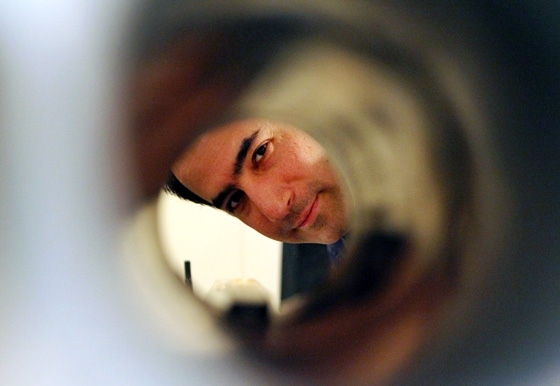After finishing his PhD in molecular biophysics, Alan Jasanoff decided to veer away from that field and try looking into some of the biggest questions in neuroscience: How do we perceive things? What happens in our brains when we make decisions?
After a few months, however, he realized that he didn’t have the tools he wanted to use — so he decided to start making his own.
Jasanoff, who recently earned tenure in MIT’s Department of Biological Engineering, now specializes in developing novel brain-imaging agents that can reveal information more detailed than other human brain-imaging techniques such as fMRI and PET, and more comprehensive than traditional neuroscience measurements such as microscopy and electrode recordings. With the new tools, he is also beginning to explore some of the fundamental questions that first drew him into neuroscience.
Neuroscientists commonly use fMRI, which measures blood flow in the brain, as a proxy for neural activity. In the past several years, Jasanoff has developed sensors that can be used with fMRI to image brain activity more directly, by measuring levels of neurotransmitters (the chemicals that carry messages between neurons) and calcium, which enters neurons when they fire.
Using those sensors, Jasanoff has started exploring how positive reinforcement influences behavior and decision making in animals. His work could also be applicable to fields outside of neuroscience, because intracellular signaling molecules such as calcium “are really ubiquitous — not just in neuronal signaling but signaling throughout the body, during development, immune-cell activity and so on,” says Jasanoff, who is an associate member of MIT’s McGovern Institute for Brain Research and an associate professor of biological engineering, nuclear science and engineering, and brain and cognitive sciences.

‘Timeless questions’
As a teenager, Jasanoff had a strong interest in science and two role models for a career in academia — his parents, both social scientists. Jasanoff spent his childhood first in Cambridge, Mass., where his father taught at Harvard University, then Ithaca, N.Y., where both parents were professors at Cornell University. His parents, Jay and Sheila Sen Jasanoff, have since returned to Harvard. “My sister Maya is also a professor at Harvard, so I’m the black sheep,” Jasanoff jokes.
While a senior in high school, Jasanoff got his start in science with a part-time job washing test tubes in a lab at Cornell. “That wasn’t a very technically sophisticated job, but I occasionally would hit up the local grad students and postdocs for slightly more scientific insight into what was going on,” he says.
As an undergraduate at Harvard, Jasanoff studied biochemical sciences and had a strong interest in structural biology, using the techniques of X-ray crystallography and nuclear magnetic resonance (NMR) to study molecules far too small to examine with the naked eye. “I like molecules,” he says, adding, “My mother always says it’s an outgrowth of my fascination with LEGO.”
He stayed at Harvard to get his PhD in biophysics, then went to MIT’s Whitehead Institute to begin independent research as a Whitehead Fellow. With a growing interest in some of the “timeless questions” of neuroscience, he began working on molecular-level neuroimaging — trading the relative predictability of structural biology for the complexity of a field “famous among many for its unanswerable questions,” he says.
Direct measurements
Functional MRI, or fMRI, currently one of the best ways to try to address those questions, provides an indirect view of what’s happening inside the brain, and can only reveal average activity in large regions. Meanwhile, traditional neuroscience techniques such as optical imaging provide a precise record of activity at the cellular level but cannot be done non-invasively over large areas of the brain.
Jasanoff wanted to find a way to have the best of both worlds — imaging large brain regions non-invasively, but with cellular precision.
He spent several years as a postdoc trying to achieve that in flies, until he realized that to be successful, he would have to develop his own molecular tools. “I tried one after another failed or weak experiments,” he recalls. “I sort of hoped there were off-the-shelf chemicals and reagents that could be useful for this, and that was probably foolhardy.”
Since joining the MIT faculty in 2004, Jasanoff has developed sensors that can be used with fMRI to monitor the neurotransmitters dopamine and serotonin, as well as calcium and other signaling molecules. The sensors, which currently can only be used in animals, include a section that binds to the target molecule, as well as a magnetic component that allows them to become visible with MRI.
Dopamine holds great interest for neuroscientists because of its role in reward, addiction and neurodegenerative disorders such as Parkinson’s disease. Jasanoff’s lab is now focusing on the role of rewards, or positive reinforcement of behavior, in decision making.
“This is one of the areas of neuroscience where I think we can make a difference relatively soon, just because we’ve got the tools for it,” Jasanoff says. “We’re also hard at work on sensors for a range of other molecular targets; our vision is to have a whole set of these probes available for ‘dissecting’ multiple aspects of neural function in living, intact brains.”








